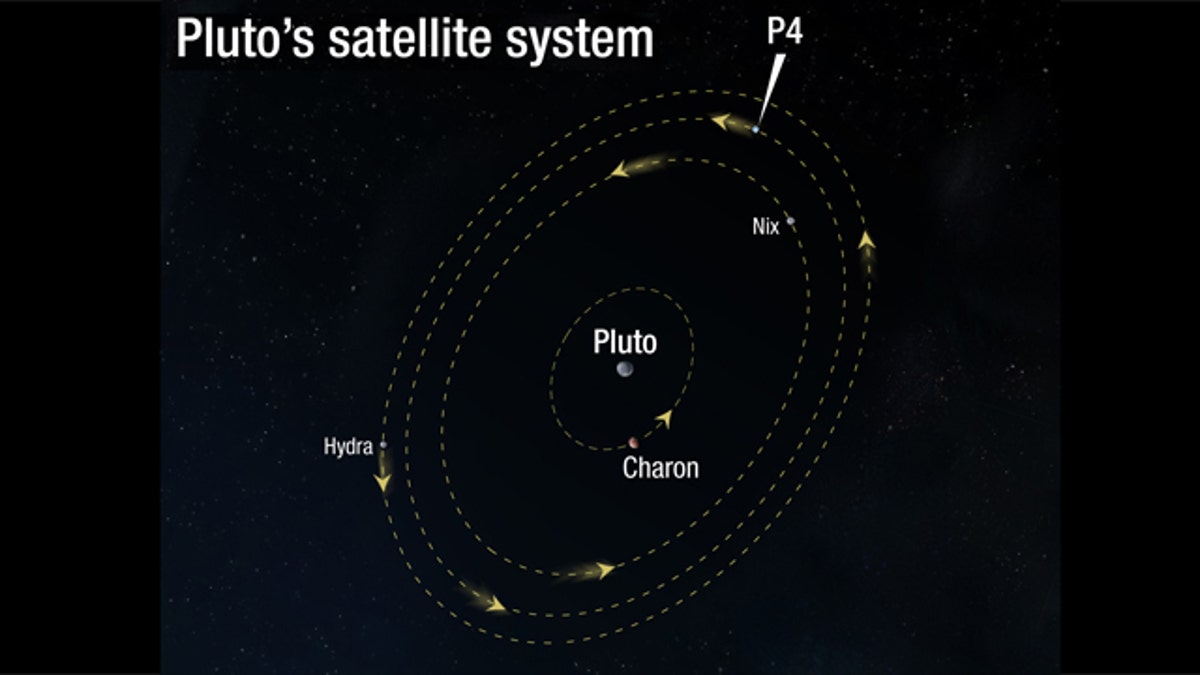
Illustration of the Pluto Satellite System orbits with newly discovered moon P4 highlighted. (NASA, ESA, and A. Feild (STScI))
A tiny new moon has been discovered around Pluto, the fourth and smallest one yet found orbiting the dwarf planet, photos from the Hubble Space Telescope reveal.
The moon, which has been temporarily named P4, was spotted in a Hubble survey searching for rings around Pluto.
The tiny satellite is estimated to be between 8 and 21 miles (13 to 34 kilometers) wide. For comparison, Pluto's largest moon Charon is 648 miles (1,043 km) across. The dwarf planet's other moons, Nix and Hydra, range between 20 to 70 miles across (32 to 113 km). [Photo of Pluto's new moon]
"I find it remarkable that Hubble's cameras enabled us to see such a tiny object so clearly from a distance of more than 3 billion miles (5 billion km)," Mark Showalter of the SETI Institute in Mountain View, Calif. said in a statement. Showalter led this observational survey with Hubble.
Pluto's new moon is located between the orbits of Nix and Hydra, which Hubble also discovered in 2005. Charon was discovered in 1978 at the U.S. Naval Observatory and was first resolved using Hubble in 1990 as a separate body from Pluto.
The finding is a result of ongoing work to support NASA's New Horizons mission, which is scheduled to fly through the Pluto system in 2015. The mission is designed to provide new insights about worlds at the edge of our solar system.
Hubble's photos of Pluto's surface and the discovery of its satellites have been invaluable for planning for New Horizons' close encounter, scientists said.
"This is a fantastic discovery," said New Horizons' principal investigator Alan Stern of the Southwest Research Institute in Boulder, Colo. "Now that we know there's another moon in the Pluto system, we can plan close-up observations of it during our flyby."
The dwarf planet's entire moon system is believed to have formed by a collision between Pluto and another planet-sized body early in the history of the solar system. The galactic smashup flung material that combined into the family of satellites observed around Pluto.
P4 was first seen in a photo taken with Hubble's Wide Field Camera 3 on June 28. It was confirmed in subsequent Hubble pictures taken on July 3 and July 18. The moon was not seen in earlier Hubble images because the exposure times were shorter.
There is a chance that P4 appeared as a very faint smudge in images from 2006, but was overlooked because it appeared obscured, scientists said.
Photos of Pluto and Its Moons
Inside Dwarf Planet Pluto
Pluto's Atmosphere Found Poisonous and Surprisingly High
Copyright © 2011 Space.com. All Rights Reserved. This material may not be published, broadcast, rewritten or redistributed.
